Kavkema are naturally fond of cosmetics, although practical demands to camouflage have forced practical fashion to alternates between “none” and “understatement”.
Kavkem colour vision can recognise a large array of colours, but as kavkema are nocturnal, they nonetheless prefer vivid, high saturation colours that are distinct from each other both in colour distance and in delineation, comparable to aztec art.
When used, cosmetics are usually highly personal, representing something that makes sense to the individual kavkem wearing the markings. Preferential areas for markings are, in order:
- long arm feathers (considered inherently decorative, even in absence of dyes - like human hair), usually individually dyed
- muzzle, usually given intricate designs
- forepaws, usually stained
- plume feathers, usually individually dyed
Nonetheless, the larger organisations have agreed on markings that they might choose to wear for meetings within (or even between) groups, if a matter is formal enough. It's important to understand that these are rarely used, and even if they are used, they'll typically be used in conjunction with personal markings, or spun into variations. Nonetheless, the following markings would be recognised by (organised, non-solitary) kavkema:
| Organisation | Markings | as image |
|---|---|---|
| Dynash | Red 'stained' muzzle (for powered dyes, you can bet much sneezing ensues during dye application) and left wrist, dyed front plume. The markings are supposed to represent the blood of Nayabaru, given Dynash's philosophy of destruction of all things Nayabaru. | 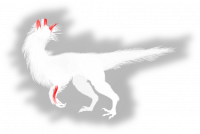 |
| Shy͡ilun | Blue beard feathers and inner thigh. The fairly well-hidden markings on the inner thigh count as a kind of organisational understatement, promising subtle but supportive methods. The “beard” feathers stand in for a spoken promise never to give up. | 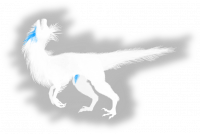 |
| Za'alseki | Yellow ring patterns in the mane, culminating in a final one around the muzzle. These are representations of the kavkem habit of keeping a 'tool necklace', and their importance to a fairly cerebral organisation such as Za'alseki. | 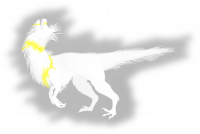 |
There are also markings known to represent certain roles or histories (also usually intermingled with other cosmetics):
| Purpose | Markings | as image |
|---|---|---|
| Ryrhakenem | Purples around the left eye, purple dye at the back of the neck, forking at the bottom of the neck into two bands, each reaching down across the shoulder to the chest. This is one of the only markings that's comparatively common - ryrhakenema often take the hit to their camouflage for the sake of being identifiable as a ryrhakenem by their fellow kavkema from afar. | 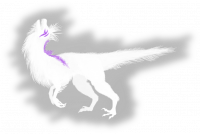 |
| Survivors (escaped previous captives) | A survivor might mark themselves with a turquoise underbelly in a context or environment where survivor opinion is considered particular important. They might also not - it's easy for captives to assume other kavkema may consider them mentally unstable (which is rarely true, but not unheard of), so it takes a certain self-confidence to admit. | 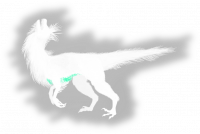 |
| Nayabaru killer | Especially common in Dynash circles - each Nayabaru the kavkem assisted in killing is worth a fuchsia line across the thigh, akin to notches in a belt. | 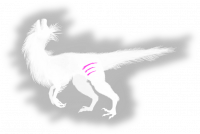 |